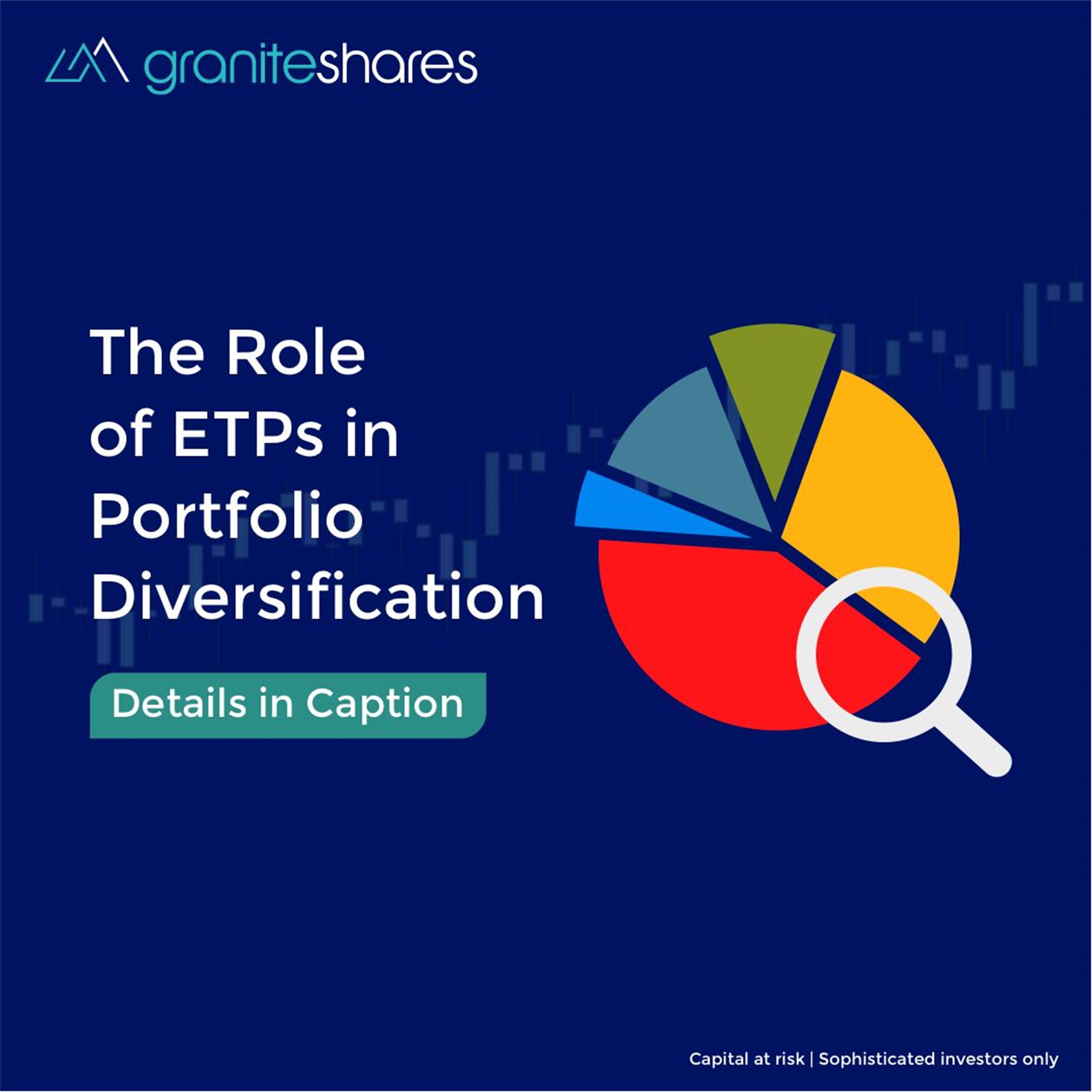The Role of ETPs in Portfolio Diversification
Posted:
Exchange-Traded Products (ETPs) have become increasingly popular among investors due to their flexibility, liquidity, and cost-effectiveness. These financial instruments, which include Exchange-Traded Funds (ETFs), Exchange-Traded Notes (ETNs), and Exchange-Traded Commodities (ETCs), offer investors a convenient way to gain exposure to a wide range of asset classes.
ETPs allow both institutional and retail investors to diversify their portfolios without the complexities often associated with traditional methods of diversification. As a result, they have grown into a staple tool for portfolio construction, attracting attention for their ability to balance risk and return.
Portfolio diversification is a key strategy for minimizing risk and optimizing long-term returns. By spreading investments across different asset classes, sectors, and geographies, investors can reduce the impact of poor performance in any single investment. This is where ETPs play a crucial role, offering a broad and accessible range of assets in a single trade. This article explores how ETPs contribute to portfolio diversification and why they are an essential tool for investors looking to build resilient portfolios.
Understanding ETPs
ETPs are financial instruments that trade on major exchanges, similar to individual stocks. They provide exposure to a variety of asset classes, including equities, bonds, commodities, and even currencies.
The most common types of ETPs include Exchange-Traded Funds (ETFs), which track the performance of an index or a basket of assets; Exchange-Traded Notes (ETNs), which are unsecured debt securities that track an index but do not own the underlying assets; and Exchange-Traded Commodities (ETCs), which offer exposure to physical commodities like gold, oil, or other raw materials. ETPs are favored for their ease of trading, transparency, and typically lower costs compared to traditional investment vehicles like mutual funds.
A key feature of ETPs is their ability to offer diversified exposure through a single investment. For example, an ETF might track the performance of the S&P 500, giving investors access to 500 large-cap U.S. companies in one trade.
This structure provides an efficient way for investors to diversify their portfolios across multiple assets, sectors, or regions without needing to individually buy and manage each component. The transparency of ETPs allows investors to see exactly what assets they are exposed to, offering a clearer understanding of how their money is being invested.
Additionally, ETPs are known for their liquidity, as they can be bought and sold throughout the trading day on exchanges, much like individual stocks. This intraday trading capability provides flexibility and the potential for timely market entry and exit, unlike mutual funds, which typically settle at the end of the trading day. These features make ETPs particularly attractive to both long-term investors looking for diversification and short-term traders seeking to capitalize on market movements.
The Importance of Diversification
Diversification is a fundamental principle of investing, aimed at reducing risk by spreading investments across a variety of assets, sectors, and regions. The core idea is that different assets often behave differently under various market conditions. By holding a mix of assets—such as stocks, bonds, and commodities—investors can balance the risk and reward in their portfolio.
When one investment performs poorly, others may perform well, cushioning overall losses and stabilizing returns over time. This strategy is particularly crucial for long-term investors seeking consistent growth while minimizing the impact of market volatility.
A well-diversified portfolio is typically structured to reduce the correlation between assets. For example, stocks in different sectors, such as technology and healthcare, may not move in tandem due to differing market drivers. Geographic diversification also plays a role, as economic conditions in one country or region may not reflect those in another. Through diversification, investors can mitigate specific risks, such as a downturn in a particular industry or country, ensuring that poor performance in one area doesn’t overly affect the entire portfolio.
However, diversification is not solely about reducing risk; it also helps optimize returns. By balancing high-growth investments with more stable, income-generating assets, investors can achieve a more favorable risk-return profile. This balance is critical because it allows investors to capture potential gains while maintaining a buffer against losses. ETPs play a vital role in this process by providing easy access to diversified asset classes and markets, enabling investors to build robust portfolios tailored to their individual risk tolerance and financial goals.
How ETPs Contribute to Diversification
ETPs provide investors with a simple and effective means of achieving diversification across a wide range of asset classes, sectors, and geographies. By holding a basket of assets within a single product, such as an ETF, investors can gain exposure to a broad market index, like the S&P 500, or more specialized areas, such as emerging markets or commodities.
This structure allows investors to diversify their portfolios efficiently, without the need to purchase individual securities. Additionally, ETPs offer access to asset classes that may otherwise be difficult to invest in directly, such as commodities or international markets, providing a more comprehensive approach to diversification.
Beyond broad market exposure, ETPs allow for targeted diversification through sector-specific or thematic products. Investors can diversify within specific industries, like technology or healthcare, or invest in themes such as clean energy or blockchain technology, depending on their investment goals. This targeted exposure helps fine-tune diversification strategies by focusing on areas of interest while maintaining the benefits of risk management. Furthermore, ETPs make it easier to implement complex diversification strategies, such as balancing between equities and bonds, or incorporating alternative assets, all within a flexible and transparent structure.
Leverage and Inverse ETPs in Diversification
Leverage and inverse ETPs are specialized products designed to amplify market movements or profit from declining asset prices, offering unique tools for diversification and risk management. Leveraged ETPs use financial derivatives to deliver multiple times the daily returns of an underlying index, providing the potential for amplified gains in bullish markets.
On the other hand, inverse ETPs are structured to deliver the opposite performance of an index, enabling investors to profit from market downturns or hedge their portfolios against declines. These products can be used strategically to enhance diversification by adding exposure to specific market conditions or as a hedge against traditional asset holdings.
However, the use of leveraged and inverse ETPs in a diversified portfolio requires caution, as their daily resetting mechanisms can lead to compounding effects that deviate from long-term expectations. While these ETPs can provide short-term benefits in volatile markets, they carry a higher risk of amplified losses if the market moves unfavorably.
As a result, they are typically used by more experienced investors for tactical purposes, such as hedging or taking advantage of specific market trends. For those employing them as part of a diversification strategy, it is important to carefully monitor positions and understand the potential risks involved.
Building a Diversified Portfolio with ETPs: Best Practices
When constructing a diversified portfolio with ETPs, it's essential to start with a clear asset allocation strategy that aligns with your investment goals and risk tolerance. A balanced approach often includes a mix of ETPs across equities, bonds, and alternative assets like commodities.
For instance, you might allocate a portion of your portfolio to a broad-market equity ETF for long-term growth, a bond ETF for income and stability, and a commodity ETF for diversification into real assets. This combination ensures that your portfolio is spread across different asset classes, reducing exposure to any single type of investment risk.
In addition to asset class diversification, consider geographic and sector-specific ETPs to further diversify your portfolio. Global exposure through international or emerging market ETPs helps reduce reliance on domestic markets, while sector-specific ETPs allow you to target industries like technology, energy, or healthcare based on your outlook.
Regularly rebalancing your portfolio is also important to maintain your desired asset allocation, as market movements can shift the weightings of your ETP holdings. Careful selection of low-cost, liquid ETPs, along with continuous portfolio monitoring, will help ensure your diversification strategy remains effective and aligned with your financial objectives.
Conclusion
ETPs have proven to be invaluable tools for achieving portfolio diversification. By offering investors access to a broad array of asset classes, sectors, and geographies, ETPs simplify the process of constructing a well-balanced portfolio.
Whether through broad-market ETFs, sector-specific ETPs, or more specialized products like leveraged and inverse ETPs, these instruments provide flexibility and cost-effective solutions for both novice and experienced investors. The ability to diversify across multiple assets in a single trade helps mitigate risks, optimize returns, and ensure a more resilient portfolio in varying market conditions.
As with any investment strategy, however, it's important to use ETPs thoughtfully, considering both the potential benefits and associated risks. Whether leveraging broad exposure or more targeted strategies, investors should tailor their ETP choices to align with their goals and risk tolerance, regularly rebalance their portfolios, and stay mindful of market conditions. With careful selection and monitoring, ETPs offer a dynamic and efficient way to build and maintain diversified portfolios, ultimately contributing to long-term financial success.
Leverage ETPs by GraniteShares
Leverage ETPs by GraniteShares
| Product name | Ticker | ||
|---|---|---|---|
| USD | EUR | GBX | |
Disclaimer
This is a disclaimer stating that all trading and investing comes with risks. Always do your research and do not invest more than you can afford to spend. GraniteShares accepts no responsibility for any loss or damage resulting directly or indirectly from the use of this blog or the contents.
This blog does not constitute an offer to buy or sell or a solicitation of an offer to buy securities in any company. Nothing contained herein constitutes investment, legal, tax or other advice nor is to be relied upon in making an investment or other decision. No recommendation is made positive or otherwise, regarding individual securities or investments mentioned herein. Any summary list of risk factors does not purport to be a complete enumeration or explanation of the risks involved in a particular investment. Prospective clients must consult with their own legal, tax and financial advisers before deciding to invest. This email contains the opinions of the author and such opinions are subject to change without notice. The source of data is GraniteShares unless otherwise stated. No guarantee is made to the accuracy of the information provided which has been obtained from sources believed to be reliable. This email and the information contained herein is intended only for the use of persons (or entities they represent) to whom it has been provided. Past performance is not a reliable indicator of future results. The value of an investment may go down as well as up and can result in losses, up to and including a total loss of the amount initially invested. Investments may involve numerous risks including, among others, company risks, general market risks, credit risks, foreign exchange risks, interest rate risks, geopolitical risks and liquidity risks. Please note that GraniteShares short and leveraged Exchange Traded Products are for sophisticated investors.
GraniteShares Limited is contracted by GraniteShares Jersey Limited to provide operating and marketing services.

GraniteShares
GraniteShares

